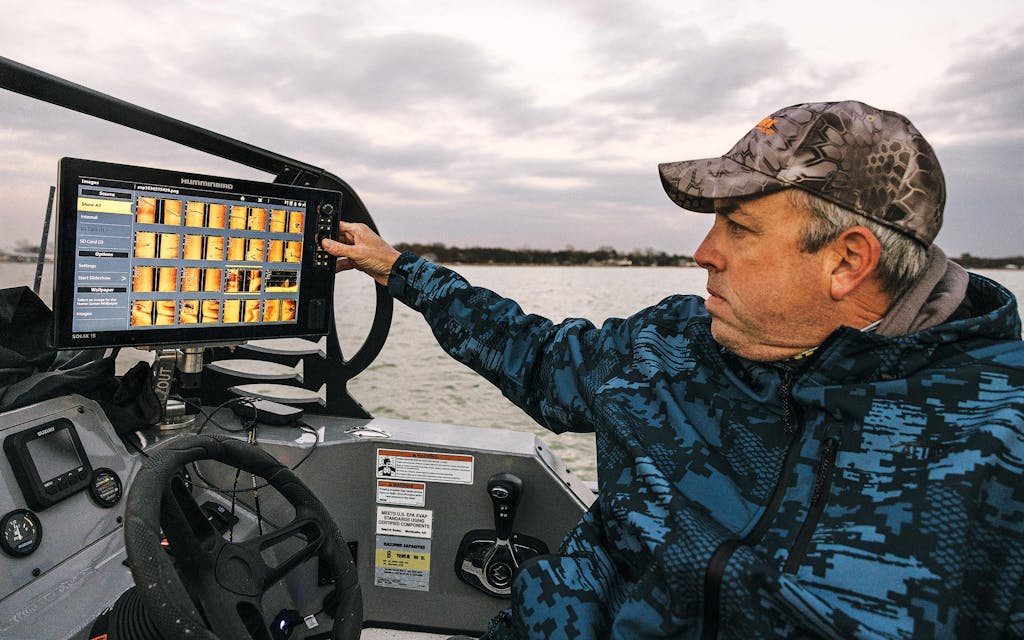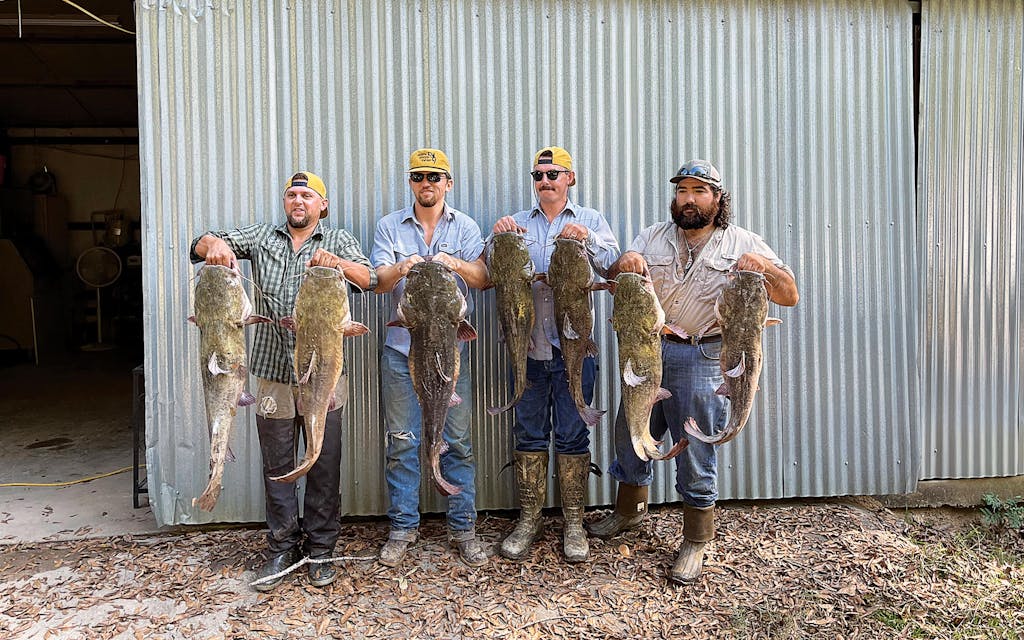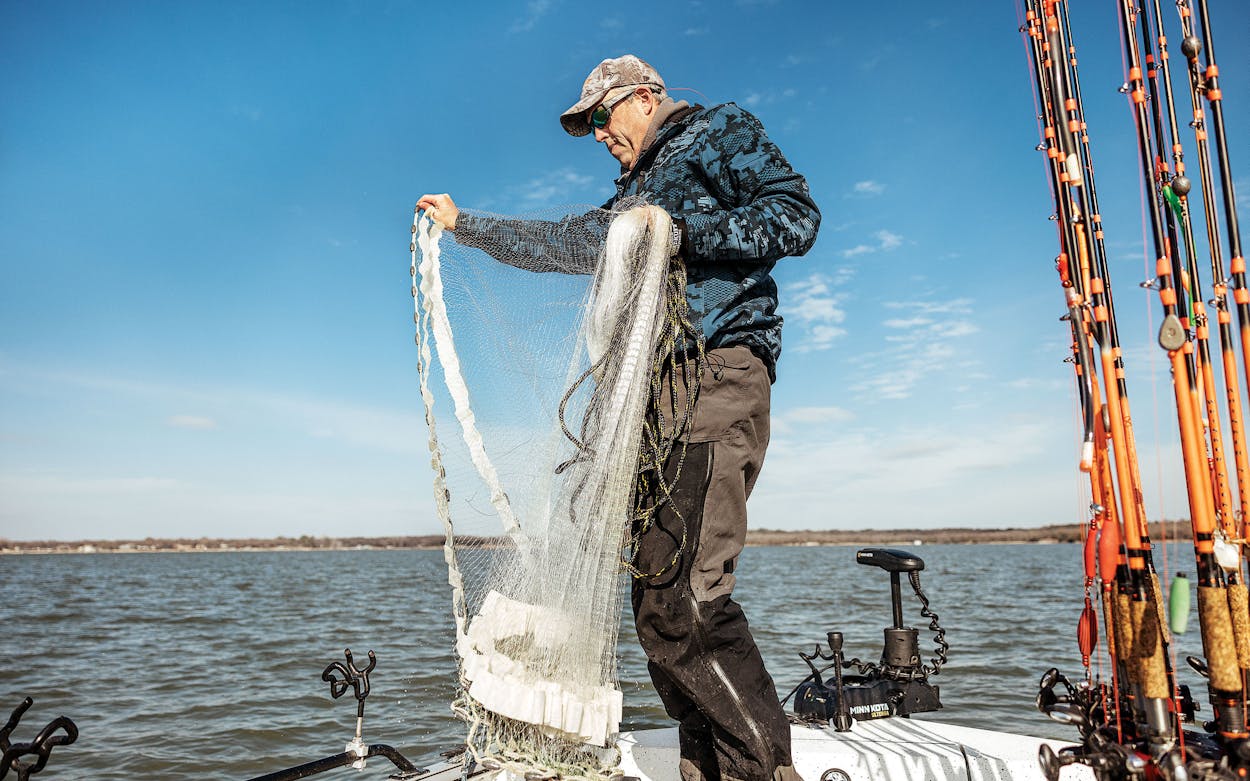Chrissy Twomey was in no mood for guff when her husband, Jonathan, woke her at 2 a.m. on a spring morning in their family’s East Texas fishing camp, along the Sabine River in rural Panola County. “I was grumpy. I was tired,” recalled Chrissy, a 42-year-old champion catfish angler from Carthage, about fifteen miles away. “But I got up and pulled my boots on.” Another tournament awaited the couple in the darkness.
Chrissy steered upstream through fog so dense she couldn’t see the front of her boat. “It was kind of like out of a Scooby-Doo movie,” she told me later. The couple approached their first fixed “throw line,” whose five hooks Jonathan had baited the day before with live perch. He’d then tied it to a branch poking out of the river, which was now jerking and slapping the water—a very good sign. Jonathan’s heart raced as he lifted the heavy line, only to realize he’d hooked not one but two huge blue cats, at least forty pounds each. In the surprisingly lucrative world of Texas catfish tournaments, that meant big money could literally be on the line. Chrissy and Jonathan weren’t ready to celebrate, though; these fish were jostling each other. In a flash, one or both could slip away.
Chrissy dipped a net into the water, but in the commotion, it snagged on the thrashing branch. With a “gosh dog it,” Chrissy grabbed two other nets, but they got caught on some of the fish hooks spaced along the line. “I was yelling at her,” 37-year-old Jonathan recalled. “I had two big fish right beside each other, and I was worried about them getting off, so I was throwing a fit. Next thing I know, she done leaned over the boat.” To Jonathan’s amazement, Chrissy used both arms to wrestle the slimy, whiskery cats one at a time, grabbing them behind their pectoral fins. “She had one like this and one like that,” Jonathan said, pantomiming his wife’s swift action, “and she threw them over in the damn boat. I shut my mouth after that.” Although they no longer remember how much money they won from the weekend-long tournament, their haul, which totaled 108 pounds of fish, was good enough to clinch a second-place trophy.
The Twomeys prefer to fish with throw lines, which are typically tied to a tree limb or fallen log, strung with baited hooks, and then lowered into the water, with a weight to keep them in place, but there’s no shortage of methods to bring in a mess of cats. You can fish for them with a rod and reel, set out a multi-hook trotline tied between trees on opposite sides of the bank, or scatter a few weighted lines tied to floating jugs. You can also use your own wriggling fingers as bait and grab the fish by the mouth when they bite—an art known as noodling, which has been legal in Texas since 2011. The catfish anglers who’ve traditionally haunted the state’s rivers and lakes are most commonly looking to reel in a little table fare, whether their freshwater bounty is sliced into filets, cubed as nuggets, or served whole, bones and all. Catfish are usually coated with cornmeal and fried in oil or bacon grease (although baked, blackened, and sautéed catfish are also all pretty tasty). Over the past decade, this longtime recreational pursuit has also become a hypercompetitive sport second only to angling for largemouth bass, the state’s most popular freshwater game fish.
“They say that the bass is king in Texas, but I’d like to think there’s a new prince coming along,” said John Tibbs, catfish-management coordinator and inland fisheries district supervisor for the Texas Parks and Wildlife Department. Advances in boats, tackle, and fancy sonar equipment have made it much easier to track down and haul in trophy-size flatheads and blue cats, the two largest catfish species in Texas, each of which frequently weighs fifty pounds or more. Photos and videos on social media are also driving the catfish craze. TV shows from the National Geographic Channel’s Mudcats to Animal Planet’s Hillbilly Handfishin’ have capitalized on viewers’ fascination with monsters lurking just below the surface. “This is almost a golden age of catfish angling in Texas,” Tibbs said. “There are still a lot of people catching fish and eating them, but we’ve seen dramatic growth in the catch-and-release ethic in catfishing.”
Chad Ferguson has been a catfish guide for the past quarter century, so he’s seen the explosive growth of the sport firsthand.
“There have always been people out there who just wanted to go out and catch a few fish, but the guys that are serious about it, really dedicating a lot of time, energy, and money to chasing and catching catfish—that segment has really grown in the last ten to fifteen years,” said Ferguson, who owns North Texas Catfish Guide Service, in Fort Worth, and designs catfishing products for Whisker Seeker Tackle, an Iowa-based supplier. He also runs Catfish Edge, a website with how-to blogs and videos. “If you’d told me twenty-five years ago that guys would be spending seventy thousand dollars on catfish-specific boats with high-end electronics, I wouldn’t have believed it, but it’s happening,” he said.

The best catfish boats are kitted out with sonar imaging technology, for tracking prey in real time. They also have large live wells (which circulate fresh water from the river or lake)—up to one hundred gallons, or about four times the size of a well in a standard bass boat—to keep monster catches alive during long trips. What these boats do not have is carpet, so it’s easier to wash the slime out.
Despite rising interest in the sport, however, it’s been a minute since any statewide catfish records have been toppled. Texas’s champion blue catfish, weighing in at a whopping 121.5 pounds, was landed in 2004 on Lake Texoma, on the Oklahoma border, with shad bait and a rod and reel. The state-record flathead, at 114 pounds, was caught on a trotline in Lake Livingston, about eighty miles north of Houston, way back in 1976. Tibbs thinks it’s time for those records to fall. “I fully expect the state record and maybe the world record”—143 pounds for blue cats, 123 pounds for flatheads—“to be broken in the next ten years,” he said. “It’s not at all surprising that we’ve got all these tournaments popping up and becoming much more popular.”
On the competition scene, catfishers increasingly vie for thousands of dollars in prize money. The Central Texas Catfish Trail group coordinates half a dozen lake tournaments throughout the year. In East Texas, the competitions tend to be less organized, and logistical information can be hard to come by. One of the most popular tournaments—the King of the Sabine—is marking its tenth anniversary April 22–24 just outside Tatum, but you have to follow a Facebook account called East Texas Wild Hog Buying for the details (along with many photos of feral pigs).
Last fall, I checked out a weekend catfish tournament, with a prize pot worth thousands of dollars, being held at River Ridge, a rustic fish camp and guide operation on the Sabine about fourteen miles southeast of Carthage. On this remote stretch of the waterway, pale sandbars mound along the bends as the river snakes toward the state line with Louisiana, and big cats abound.
Jonathan and Chrissy Twomey were competing on a three-person team rounded out by Jonathan’s dad, Hank. They baited several throw lines with live perch the first evening. About two hours before sunrise the next morning, the Twomey trio was boating through the dark when they noticed one of their lines pulled taut beneath a fallen log. They quickly tugged up the line and hauled in a mighty flathead—also known as an Opelousas cat, or Op for short.
Unlike channel cats, which are opportunistic feeders that will eat nearly anything (anglers have reported finding everything from chicken bones to a pack of cigarettes in their stomachs), flatheads—and to some extent, blue cats—prefer to target live prey. Flatheads are yellowish or brown with a square tail (blue and channel cats are gray with white bellies and a forked tail), and their long whiskers actually are taste-bud-laden appendages called barbels, which they use to detect food as well as to navigate in dark, murky water.

Back at the metal shed serving as tournament headquarters, Jonathan wrangled the slippery fish into a plastic bin to be weighed by competition judge Jane Gallenbach, who is a bass-fishing guide and the co-owner, with her husband, Tom, of River Ridge. She also happens to be Hank’s sister and Jonathan’s aunt. Tom, a retired game warden, declined to help Jonathan lift the heavy catch onto Jane’s digital scale. “I’m a tournament official,” he said. “I don’t want to be accused of bias or nothing.”
Jane read off the results. The fish weighed an impressive 51.1 pounds—the Twomeys’ personal best for flatheads. The catch netted them $500 for winning the tournament’s “Big Op” side pot, which warranted a family photo. “I’ll hold this one,” said Hank, proudly claiming the big fish as his trophy. As his dad hoisted the flathead into the air, Jonathan raised two smaller fish they’d caught, draping one over Chrissy’s shoulder. “I’m shaking! Hurry up!” Hank said, his forearms quivering as Jane snapped pictures.
As Jonathan got ready to return the celebrated flathead to the river, I asked if I could tag along the next time the family ran their trotlines that evening. He declined. “We’ve got a boatful,” he said. As more fishing teams trickled in throughout day, I kept asking around, but no one had room for one more. Their boats didn’t look all that small to me. Did these competitors suspect that I would steal their jealously guarded fishing secrets? I’m still not sure.
Afterward, I asked Tibbs to share some tips for the catfish-curious who don’t have access to a boat. “A large number of anglers start out fishing from shore,” he assured me. March and April are good months to hook blue cats, he said; he advised using pieces of chicken breast as bait. If the weather is cool or mild and the breeze is blowing toward the shore you’re fishing from, he suggested casting to a sunny spot near land, where fish are likely to congregate. Tibbs also recommended a visit to one of the eighteen ponds and small lakes that are routinely stocked via TPWD’s Neighborhood Fishin’ program, which is offered in nine metro areas around the state. “The fishing will be fairly predictable,” he said, which is an asset for novices.


TPWD has taken other recent steps to make catfishing more accessible. In September, it simplified regulations for blue and channel cats. The daily bag limit is still 25 catfish, but anglers were previously required to toss back any that hadn’t reached a length of twelve inches or more. The agency has scrapped the minimum length requirement, so it’s fine to load up on smaller fish. Tibbs doesn’t expect the change to put a dent in the state’s catfish population, and less-informed fishers won’t be as likely to run into trouble with game wardens.
On the other end of the fishing spectrum, TPWD has increased its protections for bigger cats. Of the 25-fish daily bag, anglers are allowed to keep only 10 blue and channel cats that measure twenty inches or longer. (There are some exceptions for specific lakes, so be sure to double-check the regulations on the agency’s website.) “The reason we want to limit the take of these larger fish is because they’re so difficult to replace,” Tibbs said. “A forty-five-pound catfish could be twenty-five years old.” By encouraging the catch and release of bigger fish, he said, these trophies will live on for the next lucky angler to catch. “They’re so much more valuable as a trophy fish,” he added.
The bag limit for flatheads remains five per day, with a minimum length of eighteen inches.
Although some anglers argue that huge catfish taste fine if you know how to prepare them correctly—Hank Twomey swears by trimming off the fat and letting the meat chill in an ice chest for a couple of days before cooking—most backwoods cooks would argue that smaller cats have better meat texture than older fish. They are also tastier and easier to handle. Another benefit: one-to-two-pound catfish haven’t lived long enough to accumulate as many toxins, such as methylmercury.
A catfish might live for five to ten years before reaching twenty inches. Once it does, the fish is generally able to catch and eat larger prey and suddenly hits a growth spurt. Tibbs has a hunch that catfish get wiser with age and experience, like most predators. “Are some fish just smarter than other fish, and they get better at catching their prey?” he wondered. “Just because their brain is the size of a pencil eraser doesn’t mean they can’t learn things.”
Human beings, with relatively bigger brains, are still learning to outwit them.
This article originally appeared in the March 2022 issue of Texas Monthly with the headline “Where Catfish Are King.” Subscribe today.
- More About:
- Hunting & Fishing
- Fishing









